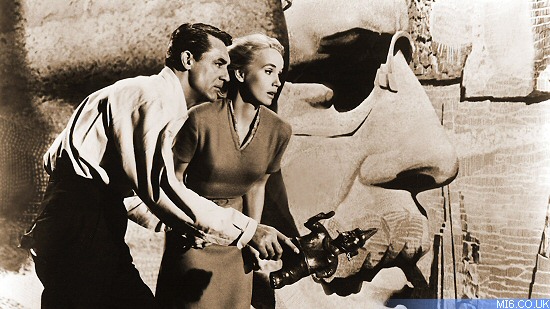North By Northwest (1959)
|
|
Synopsis
From New York to Mt. Rushmore, advertising executive Roger O. Thornhill (Grant) is assumed to be infamous government spy George Kaplan. Thugs Philip Vandamm and Leonard peruse the hounded Thornhill from New York to Chicago and on to South Dakota. En route, Thornhill meets the lavish and lovely Eva Kendall who comes to his aid on more than one occasion and in the climax of the film the hero must pull out all the stops to rescue his damsel.
"Now you listen to me, I'm an advertising man, not a red herring. I've got a job, a secretary, a mother, two ex-wives and several bartenders that depend upon me, and I don't intend to disappoint them all by getting myself 'slightly' killed." - Roger Thornhill
Vital Statistics
Studio: Metro-Goldwyn-Mayer
Running time: 131 minutes
Budget: $4 million
Box-Office (Domestic): $13.27m |
|
Cast & Characters
 |
Roger Thornhill
Carry Grant |
 |
|
 |
Eve Kendall
Eve Marie Saint |
 |
|
 |
Philip Vandamm
James Mason |
 |
|
 |
Mrs. Townsend
Josephine Hutchenson |
 |
|
 |
Lester Townsend
Philip Ober |
 |
|
 |
Leonard
Martin Landau |
 |
|
 |
Clara Thornhill
Jessie Royce Landis |
 |
|
 |
Victor Larabee
Edward Platt |
 |
|
 |
Valerian
Adam Williams |
 |
|
Locations
Manhattan, NY, USA; Long Island, NY, USA; Chicago, IL, USA; Rapid City, SD, USA; Mt. Rushmore, SD, USA.
Trivia
The 1959 film brings to mainstream feature films a title sequence style known
as Kinetic Typography: the technical term for moving text. The titles for "North
By Northwest" were
one of the first to fly and fade from the screen.
Title
The title echoes the famous line from Shakespeare's "Hamlet". Working titles for the production included "In a Northwesterly Direction" (as the plot sees the character travel from New York to South Dakota) and "The Man on Lincoln's Nose".
The Bond Connection
Released three years before the first 007 adventure,
in "North By Northwest" Carry Grant plays a suave marketing agent who,
through a drastic mistaken identity, winds up being stalked across the States
by a series of assassins. Roger Thornhill (Grant) has to use his instincts and
spur-of-the-moment resource to evade the spies on his tail. Hitchcock crafts
a spy thriller that lives on as a classic in its genre, inspiring Terence
Young and many other spy-film directors. "North By Northwest" is considered
by many film historians to have set the template for the modern
action film, which 007 would capitalise on three years later.
 Above: Carry Grant and Eve Marie
Saint in a promotional still for the film's marketing campaign.
Above: Carry Grant and Eve Marie
Saint in a promotional still for the film's marketing campaign. |
|
Production Notes
On the back of the success of Hitchcock's crime-thriller "Vertigo" (1958) the acclaimed director set about production on a truly great spy thriller.
"North By Northwest" harps back to some of his famed pictures of the 1930's: "The Man Who Knew Too Much" and "The 39 Steps" as
an even more modern entry to the spy genre. Undeniably a classic production
and an influence on the spy-fi genre, Hitchcock rolled cameras on his adventure
in 1959 on his 51st film as director in August 1958.
Already an accomplished filmmaker with
a staggering number of films to his name, Hitchcock went
about the production of "North By Northwest" over
a five month period. The picture was not only creatively
pioneering but also technically noteworthy. Hitchcock experimented
with Paramount Pictures' widescreen film format 'VistaVision'.
The technology was capable of being screened at an aspect
ratio of up to 2:00:1 and was also flexible
enough to be printed on standard 35mm film.
|
The production shot in Culver City, LA; Chicago,
IL; New York, NY; and Keystone, SD. At the time the United Nation
(whose building proves a key location in the production) had
strict
rules and regulations around filming in the area. Hitchcock shot
a few "guerrilla" sequences from a disguised van that
saw Grant entering and exiting the building on First Avenue.
Whilst the director was able to can the sequences in the midst
of New York City, gigantic sets were built at MGM in Culver City,
including a mock up of the Mt. Rushmore monument and a Lloyd
Wright-esque mansion.
 |
The director, who reportedly wished to lighten
the tone of his pictures after the "Vertigo" affair,
conceived of the film based on an idea he had to see his hero
visit the great American monument at Mt. Rushmore. Thematically
the film is deeper than a plot synopsis does justice. Screenwriter
Ernest Lehman plays with concepts of trust and the seemingly
intangible ideas of the truth and his character's questioning
of the real world.
For the scriptwriting, Ernest Lehman won an Edgar Allan Poe Award for Best Motion Picture and the picture itself earned Golden Laurel Award.
Related Articles
 Beyond Bond Index
Beyond Bond Index